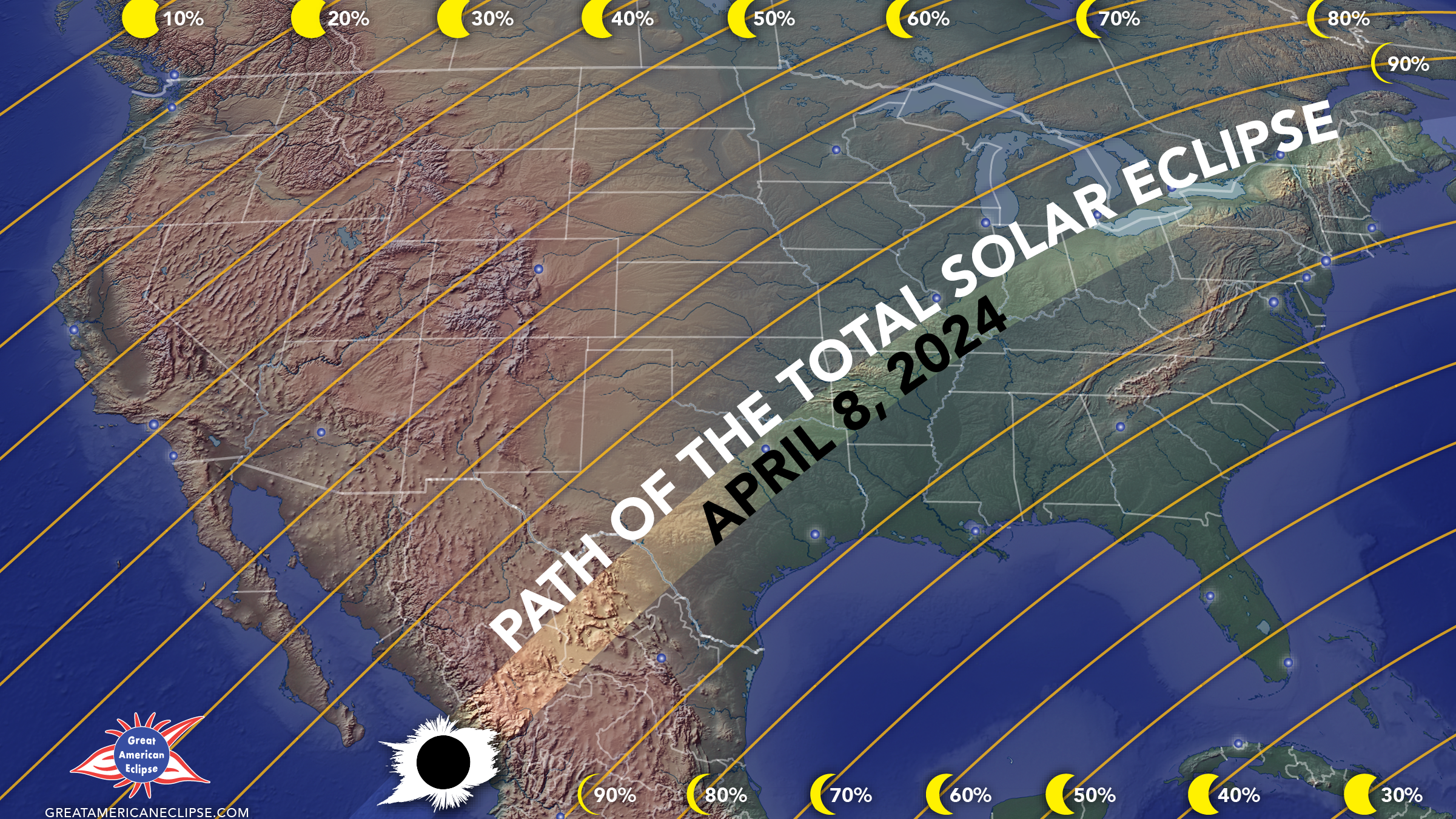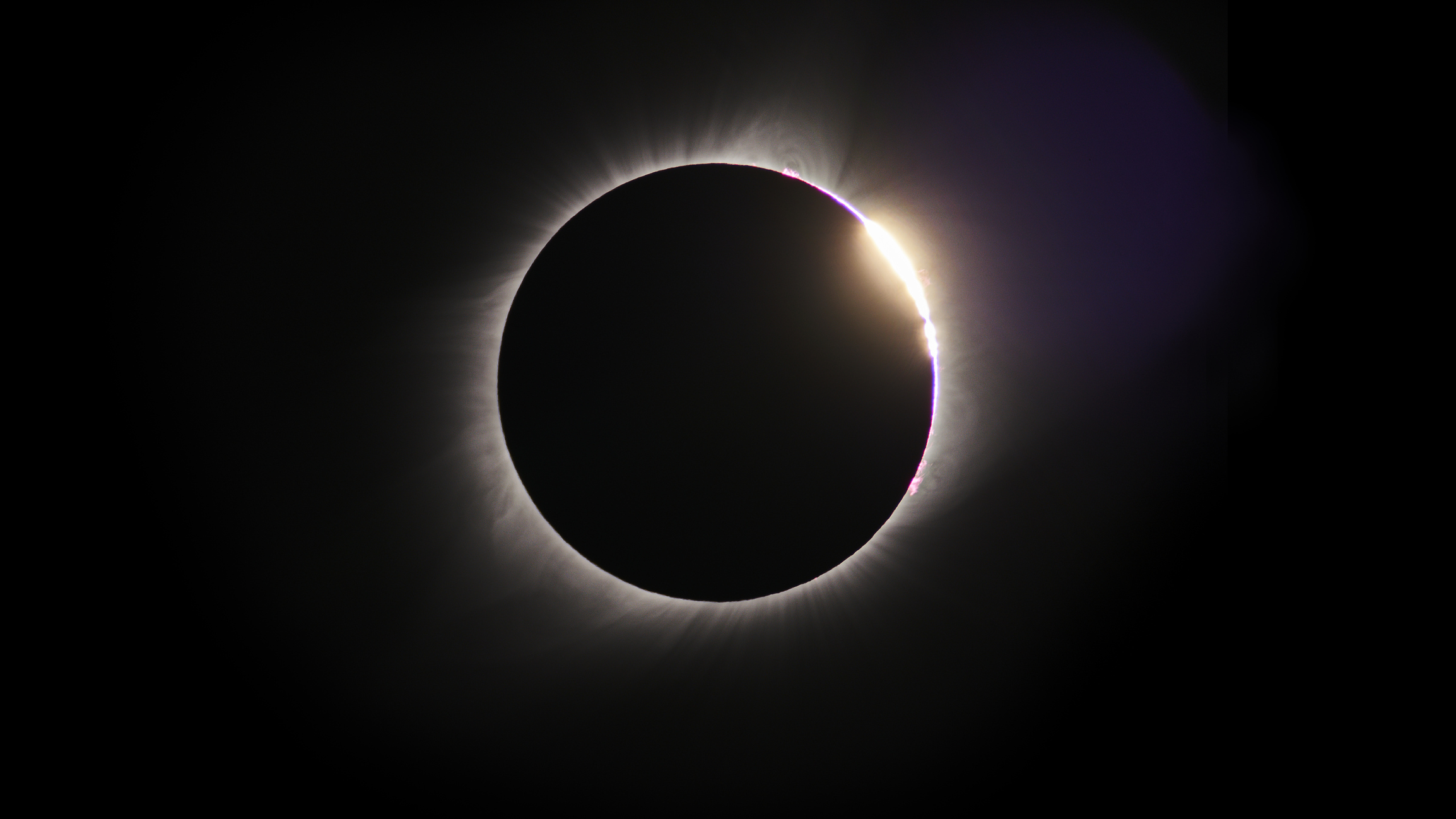'99% totality' does not exist! Why you need to get to the path for April 8, 2024, total solar eclipse
Thousands of people will get the eclipse wrong on April 8, 2024. Don't be one of them.

There's a reason why the path of totality is called what it is. Mistakes will be made by many would-be eclipse-chasers during the total solar eclipse on April 8, 2024.
Inside the 115-mile wide path of totality — which will stretch across North America that day — some will forget to take off their eclipse glasses (during the moment of "totality"), missing a once-on-a-lifetime view of the solar corona.
Others will lose track of time and be queuing for the bathroom as the moon totally eclipses the sun. However, the biggest celestial crime it's possible to make when a total solar eclipse comes to town is to settle for 99%.
Related: What's the difference between a total solar eclipse and an annular solar eclipse?
You can watch the total solar eclipse live here on Space.com. And keep up with all the actions with our total solar eclipse 2024 live updates blog.
There's no such thing as "99% totality"
"I'm happy with a 99% eclipse," is a common refrain, particularly from residents who live near to, but not actually inside of, the path of totality. It happens at every eclipse. And after every single one, these people agree that, yes, the eclipse was interesting — and they dodged all the traffic! The light perhaps faded a little bit. It was fun using the eclipse glasses. It may have got a little colder.
"There is no such thing as a 99% total solar eclipse," Dr. Rick Fienberg, Project Manager, AAS Solar Eclipse Task Force at the American Astronomical Society, said in a press briefing. "Just like there's no such thing as being 99% pregnant — it's all or nothing."
Breaking space news, the latest updates on rocket launches, skywatching events and more!
Research the path and you will come across places offering "99% coverage' or '99% totality". "They've got some real estate or a campground that they want to sell, but unfortunately they're not in the path of totality," Fred Espenak, an eclipse-chaser and retired calculator for NASA who runs MrEclipse.com, told Space.com. "So they're trying to put their best foot forward and say, well, it is 99%".
It's also true that the uninitiated who stand outside the path of totality won't have a clue what the problem is. "For people who don't know anything about eclipses and have never seen one before, a 99% partial eclipse will be incredibly spectacular and amazing," Espenak said. "Unless they've already seen a total solar eclipse they won't know what they've missed."
While the 99% crowd is enjoying a thin crescent sun, more clued-up folks just a few miles down the road experience pure joy and, in some cases, cry their eyes out.
Understanding the path of totality
It should be self-explanatory, but the path of totality is often misunderstood. On April 8, 2024, it will stretch over 9,000 miles across the planet, but on average will be just 115 miles wide. It's the cone-shaped inner (umbral) shadow of the moon projected onto Earth's surface and only from within it does the moon appear to entirely block the sun.
"When you're trying to think about where you want to go, the first decision is whether you want to get into the path," Fienberg said. "Only in the path will you see what's special about this eclipse — totality."
Related: How to read and understand a solar eclipse map
What can only be experienced in the path of totality
Stand in the path of totality and you get treated to the full array of celestial spectacles only this event can offer. Unique sights and experiences include:
- Darkness in the day (typically a deep twilight) during totality.
- A view of the solar corona during totality.
- A view of pinkish 'prominences' (explosions) on the limb of the sun during totality.
- A 'diamond ring' that begins and ends totality.
- Shadow bands on the floor a few minutes before and after totality.
- A noticeable drop in temperature.
A lot of this comes with emotions that you just can't have at any other time. As it gets dark it's hard to shake a primeval feeling that the sun might not come back. However, it's that view of the solar corona — the sun's wispy outer atmosphere — that's the most precious sight. Does the sun really look like that? Seeing the sun as it really is for the first time — a vast, spiky star in space — is a profoundly beautiful and shocking sight.
What you see out of the path
Outside of the path of totality you will see a common partial solar eclipse — and experience zero totality. If you're standing somewhere and witness a 99% partial solar eclipse then, sure, it's a significant moment. The sun right down to a tiny slither. The light levels drop and birds may even start behaving strangely. But just as the sun has reduced to a slither it will begin to grow again. The light, if it did noticeably dim, will return near enough to normal within a few seconds.
The difference between a 99% partial solar eclipse and a total solar eclipse is, as the saying among eclipse chasers goes, night and day — literally. "Until you get to about 75% eclipse, you might not notice because your pupils can dilate," Fienberg said. In fact, even just five minutes before totality it will only be as dark or bright as an overcast day. "In the last few minutes, and particularly in the last minute, the brightness plummets by two to three orders of magnitude," Fienberg continued. "It is only inside the path that you get that last drop."
That's because you're standing in the fuzzy outer shadow of the moon, its penumbra, in which all you can ever see is a partial eclipse of the sun.
What you experience away from the centerline
Precisely what you see from the path of totality depends on exactly where you are. For example, if you're on the centerline of the path you'll have the whole radius of the moon's shadow shoot across you, meaning totality will last as long as possible in that geographical region. Get close to the edge and you'll still experience totality, just for a shorter time. It's a sliding scale, with the duration of totality changing little in the middle third of the path, though it tumbles quickly close to the edges.
Why the edge of the path is fuzzy
The edge of the path of totality is a weird place. If you stand at either the eastern or western limits of the path of totality the totally eclipsed sun is but a fleeting sight lasting just seconds. Two people standing on either side of the edge of the path a few miles apart will have two entirely different experiences — totality on one side, and a very big partial solar eclipse on the other. In practice, it's less precise than that.
The edge is a projection of the limb of the moon, which isn't flat. Its mountains and valleys make for a ragged moon shadow, the upshot being a 'grazing zone' about three miles wide where what you see isn't easy to tell unless you're there — it's where the eclipse maps are, technically speaking, 'wrong'.
The edge is not normally visited. Some eclipse-chasers go there on purpose to see extended views of Baily's beads — when beads of sunlight shine between mountains and features on the moon — and a longer view of the chromosphere, the second layer of the sun's atmosphere.
These are technical sights desired only by experienced observers who've likely witnessed dozens of solar eclipses across the world. However, on April 8 major cities including Austin and San Antonio, Texas, will all be split in two by the edge of the path of totality. Takes San Antonio, whose famous Alamo mission, museum district and zoo get a tantalizing 99.9%.
That's a shame, but there's nothing that can be done about it. "99% and 100% are enormously different," said Espenak. "You're either in totality or you're not." With the following total solar eclipse in North America in 2044, this isn't a time to make mistakes and miss one of nature's most precious, fleeting experiences.
REMEMBER to NEVER look at the sun directly. To safely view this solar eclipse you must use solar filters at all times. Only during the exact moment of totality, when the moon completely obscures the sun can you look with the naked eye. At all other times, precautions need to be taken. Observers will need to wear solar eclipse glasses, and cameras, telescopes and binoculars must have solar filters placed in front of their lenses.
Our how to observe the sun safely guide tells you everything you need to know about safe solar observations.

Jamie is an experienced science, technology and travel journalist and stargazer who writes about exploring the night sky, solar and lunar eclipses, moon-gazing, astro-travel, astronomy and space exploration. He is the editor of WhenIsTheNextEclipse.com and author of A Stargazing Program For Beginners, and is a senior contributor at Forbes. His special skill is turning tech-babble into plain English.


